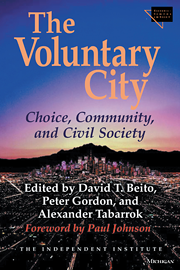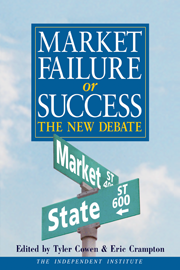A sulfa drug called Elixir Sulfanilamide released in 1937 killed over 100 Americans, mostly children. A sedative called Thalidomide released in Europe in 1957 and taken by pregnant women caused deformities in 10,000 children. These famous episodes strike us as horrible injustices that must be prevented.
But more deadly are quack platitudes that guide public policy. Platitudes such as “safety,” “consumer protection,” and “imperfect information” have paved the way for a government stranglehold on the pharmaceutical industry. The Food and Drug Administration (FDA) decides whether to permit a company to manufacture and sell a drug or medical device and what the company may say about it.
In medical matters, expertise and good sense should decide. In policy matters, expertise and good sense also should decide—but they do not. The issue here is one of economic policy, not medicine. The true “doctors” for drug policy are the political economists. But as economist John Calfee says, “the FDA has never sought to accumulate expertise in economics.”[1] Quacks make policy against the doctors’ orders.
Many economists have studied the FDA. Their diagnosis is well expressed by Nobel-winning economist Milton Friedman: “The FDA has done enormous harm to the health of the American public by greatly increasing the costs of pharmaceutical research, thereby reducing the supply of new and effective drugs, and by delaying the approval of such drugs as survive the tortuous FDA process.”[2] Other economists’ prescriptions regarding the FDA are uniformly libertarian, ranging from gradual decontrol to outright abolition of the agency (as Friedman recommends). Although one can occasionally find remarks by economists vaguely favoring government restrictions on health products, those are not the economists who have written on the FDA or provided serious argumentation.[3] I have tried to survey all economists’ writings on the FDA and have not been able to find a single instance of an economist defending the contemporary FDA or advocating tighter restrictions. Contrary to the joke about laying all the economists end to end, those who study the issue do reach a conclusion: Relax restrictions on drugs and devices.
But the good policy doctors are largely ignored. The result has been like a plague. Yet the journalists and educators have not explained it or its FDA origins. Economists and libertarians are up against a Goliath—the country’s entire quack political culture.
Today men with risk of heart trouble know to take half an aspirin a day. By 1988 it was well established that aspirin greatly reduces the risk of myocardial occlusion. But for years the FDA forbade aspirin makers from advertising that fact (the FDA still significantly restricts advertising about it). The FDA surely killed tens, and quite possibly hundreds, of thousands of Americans by this restriction alone.[4]
The FDA delays, stifles, and suppresses life-saving drugs and devices. Such drugs and devices as Practolol, Interleukin-2, Taxotere, Vasoseal, Ancrod, Glucophage, Navelbine, Lamictal, Ethyol, Photofrin, Rilutek, Citicoline, Panorex, Femara, Prostar, Omnicath, and Transform have been subject to long delays, killing tens of thousands and causing awful suffering.[5]
The drug delays we can list, taken together, are just the tip of the iceberg. A 1987 study catalogued 192 generic and 1,535 brand-name tested drugs available abroad but not approved in the United States. Of the drugs approved by the FDA between 1987 and 1993, fully 73 percent had already been approved abroad.[6] And because the FDA process is so expensive, so protracted, and so uncertain, thousands of untold drugs are never discovered or developed. It is impossible to estimate the suffering and death caused, but surely it greatly exceeds 50,000 premature deaths annually.
Here one might object, “But isn’t your diagnosis one-sided? Doesn’t the FDA screen out unsafe drugs?”
Quality and Safety Assurance Without the FDA
First of all, “safety” is not a yes-or-no issue. Is chemotherapy safe? Medicine is often poison. The safety of a drug depends on myriad particulars about the patient: age, physical strength and condition, attitude and spirit, activities, allergies, diet, dosage, medical attention, and drug regimen. In 1994 adverse reactions to FDA-approved drugs killed 106,000 hospital patients.[7] Inevitably, many people will suffer and die from unwanted side effects. (In 1998, about 130 people died while on Viagra; speculation continues overwhether these deaths are to be attributed to side effects of the drug or excitement “under the influence.”)
That said, I am prepared to grant that few FDA-approved drugs are flagrantly unsafe. But here’s the important point: Drug safety would be—and is—certified and assured by a panoply of private-sector, voluntary institutions and by the tort system. When a company harms consumers with an unsafe drug, it suffers devastating losses. Its reputation suffers, and it pays hefty damages to victims. In deciding which drugs to use, consumers seek various assurances by:
- Asking the doctor which drug to take;
- Choosing doctors affiliated with health organizations (such as hospitals, clinics, medical groups, and insurers);
- Buying drugs of brand-name manufacturers;
- Buying drugs from reputable pharmacies and supermarkets;
- Being an “active patient” by researching therapies in libraries and on the Internet (at encyclopedic drug databases, such as the WebMD or onHealth Web sites).
Meanwhile, our providers and agents seek assurances in more professional ways—mysterious to us, but not to those involved:
- Drug review by medical insurers;
- Seal of approval or evaluations by independent organizations (ECRI, American Hospital Formulary Service Drug Information, US Pharmacopoeia);
- Professional newsletters (Clinica, Health Devices Alert, The Medical Letter)
- Scientific testing and publishing (The New England Journal of Medicine, and others).
Ultimately, the whole enterprise of medical science is about safety and efficacy! Malpractice or negligence is a professional scandal for the private organizations involved. They work hard to avoid blights to their reputation, quite apart from the FDA. Consumers desire not only quality and safety but also assurance of quality and safety. The quality of the thing offered may be excellent, but if consumers lack confidence about that quality, they abstain from buying. Confidence comes by way of meaningful assurances of quality, so entrepreneurs have incentives to provide that assurance.[8]
Quality and Safety Assurance Without the FDA: Four Proofs
Although some might tell you otherwise, voluntary society (plus the tort system) can provide assurance at least as well as government intervention can. Here are four empirical proofs of the claim.
Assurance in Other Industries. How is safety assured in other industries? In electronics, manufacturers submit products to Underwriters’ Laboratories, a private organization that grants its safety mark to products that pass its inspection. The process is voluntary: manufacturers may sell without the UL mark. But retailers and distributors usually prefer the products with it.
Suppose someone proposed a new government agency that forbade manufacturers from making any electronic product until approved by the agency. We would think the proposal to be totalitarianand crazy. But that is the system we have in drugs. It is inconsistent to favor the free-enterprise approach to assurance in electronics but the totalitarian approach in drugs. Sometimes people rejoin: “You can’t compare drugs to a toaster! Drugs have much larger effects on our physical well-being.” The point, however, cuts both ways. Because drugs are so important, the downside of government restrictions is enormous—as we have seen.
Calamity Before 1962? The FDA was much less powerful before 1962. The historical record-decades of a relatively free market up to 1962—shows that free-market institutions and the tort system succeeded in keeping unsafe drugs to a minimum. The Elixir Sulfanilamide tragedy (107 killed) was the worst in those decades.[9] (Thalidomide was never approved for sale in the United States.) The economists Sam Peltzman and Dale Gieringer have made the grisly comparison: the victims of Sulfanilamide and other small tragedies prior to 1962 are insignificant compared to the death toll of the post-1962 FDA.[10]
Were They Dropping Like Flies in Europe?
Most countries have their own counterparts to the FDA. But other countries approve drugs quicker. From about 1970 to 1993 the approval times for drugs and devices in the United Kingdom, France, Spain, and Germany was significantly shorter than in the United States.[11] As we have noted, delays mean morbidity for patients. Although FDA drug approval times have improved and are now similar to those in Europe, the prior period of U.S. “drug lag” suggests a lesson about drug approval.[12]
The European agencies took less time to approve new drugs, but such laxness did not produce a scourge of unsafe drugs. As researchers of the Tufts Center for the Study of Drug Development write: “the probability that a marketed drug will be removed for safety reasons was not appreciably greater in the United Kingdom than in the United States.”[13] Lighter approval requirements did not lead to any noticeable problem. One explanation would be that the European agencies function more effectively (and there is reason to believe this). Yet I am inclined to think that in both Europeand the United States the government approval process, as a means of assuring safety, is superfluous.
Even without government approval, voluntary institutions and the tort system would use scientific testing and professional certification to screen out unsafe drugs. The government approval process here and abroad is a set of bureaucratic hoops and hurdles often inappropriate or unnecessary for the drugs in question.
The Hidden Lesson in Off-Label Prescribing
Proof that we don’t need FDA approval of drugs can even be found in America today. A drug’s FDA-approved uses are called its “on-label” uses. Once a drug is approved for any use, it may be used in any way doctors and users see fit. Approved drugs are often found to have other benefits, and doctors learn to prescribe those drugs for such “off-label” uses. Although off-label uses have absolutely no standing with or approval by the FDA, they are perfectly legal. Do patients and doctors shrink in fear from uses not certified by the FDA?
Absolutely not! Off-label prescribing is pervasive and vital to the health of millions of Americans. As economist Alexander Tabarrok says, “most hospital patients are given drugs which are not FDA-approved for the prescribed use.”[14] Off-label prescriptions are especially common for AIDS, cancer, and pediatric patients, but are standard practice throughout medicine.
Doctors learn of off-label uses from extensive medical research, testing, newsletters, conferences, seminars, Internet sources, and trusted colleagues. Scientists and doctors, working through professional associations and organizations, make official determinations of “best practice” and certify off-label uses in standard reference compendia such as AMA Drug Evaluations, American Hospital Formulary Service Drug Information, and US Pharmacopoeia Drug Information—all without FDA meddling or restriction. Economist J. Howard Beales finds that off-label uses that later got FDA recognition appeared in the Pharmacopoeia on average 2.5 years earlier.[15] Where voluntary society finds room to stand, its practices lead, not follow, government determinations.
No one would be foolish enough to suggest that the FDA prohibit off-label prescribing. But as Tabarrok astutely points out, there is a logical inconsistency in allowing off-label prescribing and requiring proof of efficacy for the drug’s initial use. Logical consistency would require that one either oppose off-label uses and favor initial proof of efficacy, or favor off-label prescribing and oppose initial proof-of-efficacy. Experience recommends the second option. Efficacy requirements should be dropped altogether!
Quackery Often Prevails
A drug may be developed, tested, and found to save lives. But the FDA will prevent Eli Lilly, Rite Aid, and Kaiser Permanente from making the drug available until it has gone through the tortuous and expensive approval process. That might take ten years. It might take forever if the drug is for a rare disease (and hence a small market). Because voluntary society would accomplish anything that the FDA accomplishes, the harms of the FDA are unredeemed.
Economists from Adam Smith to Milton Friedman have had the unenviable task of pointing out that popular, well-intentioned cures are often worse than the disease. Economists seem nasty when they report that the FDA is bad medicine. People don’t like to hear that they have bought into quackery. In collective decision-making, quackery often prevails over sense.
Notes:
1. John E. Calfee, “The Leverage Principle in the FDA’s Regulation of Information,” in Competitive Strategies in the Pharmaceutical Industry, ed. R. B. Helms (Washington D.C.: American Enterprise Institute, 1996), pp. 306–21.
2. Quoted in Durk Pearson and Sandy Shaw, Freedom of Informed Choice: FDA Versus Nutrient Supplements (Neptune, N.J.: Common Sense Press, 1993), p. 39.
3. Economists making passing remarks vaguely favoring government restrictions on health products include Jerome Rothenberg, “Social Strategy and the Tactics in the Search for Safety,” Critical Review, Spring/Summer 1993, pp. 159–80, especially pp. 166, 172, and Paul Krugman, “Natural Born Killers,” New York Times, March 22, 2000.
4. Alison Keith, “Regulating Information about Aspirin and the Prevention of Heart Attack,” American Economic Review, May 1995, pp. 96–99.
5. A chief source of information about drug development and approval is the Tufts Center for the Study of Drug Development. Its information is often mined and analyzed from a libertarian perspective by researchers at the Competitive Enterprise Institute (see both organizations online).
6. Kenneth Anderson and Lois Anderson, eds., Orphan Drugs (Los Angeles: The Body Press, 1987). Henry I. Miller, “Failed FDA Reform,” Regulation, 3, 1998, p. 24.
7. Jason Lazarou et al., “Incidence of Adverse Drug Reactions in Hospitalized Patients,” Journal of the American Medical Association, April 15, 1998, pp. 1200–05.
8. See Daniel B. Klein, Assurance and Trust in a Great Society, Foundation for Economic Education Occasional Paper no. 2, 2000.
9. Dale H. Gieringer, “The Safety and Efficacy of New Drug Approval,” Cato Journal, Spring/Summer 1985, pp. 177–201, provides a table of cases worldwide, 1950–80, with at least 100 casualties from an unsafe new drug (p. 192). There are none listed for the United States from 1950 to 1962.
10. Gieringer; Sam Peltzman, “The Benefits and Costs of New Drug Regulation,” in Regulating New Drugs, ed. Richard L. Landau (Chicago: University of Chicago Press, 1973), pp. 114–211.
11. Kenneth I. Kaitin and Jeffrey S. Brown, “A Drug Lag Update,” Drug Information Journal, 29, 1995, pp. 361–73; Robert Higgs, “How FDA is Causing a Technological Exodus: A Comparative Analysis of Medical Device Regulation: United States, Europe, Canada, and Japan,” Competitive Enterprise Institute, March 1995.
12. Elaine M. Healy and Kenneth Kaitin, “The European Agency for the Evaluation of Medicinal Product’s Centralized Procedure for Product Approval: Current Status,” Drug Information Journal, 33, 1999, pp. 969–78. It should be noted that approval is but the last stage in the development of a drug, and the FDA reaches far back into the clinical-testing stages of drug development. Therefore, looking only at approval times does not give a complete picture of whether the FDA now keeps pace with its European counterparts. Historically drug development has taken longer in the United States. Whether the “drug lag” in this broader and fuller sense is diminishing is not yet established.
13. Quoted in Kaitin and Brown, pp. 370–71.
14. Alexander Tabarrok, “Assessing the FDA via the Anomaly of Off-Label Drug Prescribing,” The Independent Review, Summer 2000, pp. 25–53.
15. J. Howard Beales III, “New Uses for Old Drugs,” in Helms, pp. 281–305.











